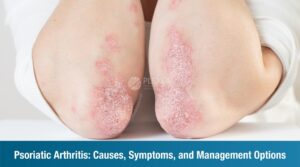
One kind of arthritis is psoriatic arthritis. People with psoriasis or those with a biological family history of the condition are typically affected.
One common condition that affects your joints is arthritis. It makes the area around your joints painful and irritated. Skin irritation is a result of psoriasis. Scaly, discolored patches of skin are known as psoriasis rashes. We refer to these thick, scaly patches as plaques. Additionally, it may cause the thickness, flaking, or pitted (covered in tiny indentations) appearance of your fingernails and toenails.
Psoriasis and arthritis are examples of autoimmune disorders. Your immune system mistakenly targets your body rather than defending it, leading to an autoimmune illness. When you experience inflammation in your joints and skin symptoms similar to psoriasis, you may have psoriatic arthritis.
The skin and joint symptoms of psoriatic arthritis typically flare up and then subside. During a flare-up, a medical professional will provide therapies to manage your symptoms.
See a doctor if you experience any new skin problems or if your joints hurt, swell, or become stiff.
To what extent is it common?
Fewer than 1% of the population suffers from psoriatic arthritis. But those who have psoriasis are far more likely to experience it. Psoriatic arthritis affects about 30% of individuals with psoriasis at some time in their lives.
 Which five types of psoriatic arthritis exist?
Which five types of psoriatic arthritis exist?
Psoriatic arthritis may be categorized by a medical professional according to the joints it affects or the side of the body where symptoms are felt. The following are the five types of psoriatic arthritis:
Distal interphalangeal predominant psoriatic arthritis: Psoriatic arthritis with a distal interphalangeal predominance affects the joints (phalanges) near the tips of your fingers and toes. It is the most prevalent kind of psoriatic arthritis that causes damage to your toenails and fingernails. Your nails may appear pitted, brittle, or discolored.
Symmetric polyarthritis: Polyarthritis simultaneously affects five or more joints. On both sides of your body, symmetric polyarthritis affects the same joints. Take both knees and both elbows, for instance. It is among the most prevalent varieties of psoriatic arthritis.
Asymmetric oligoarticular psoriatic arthritis: Two to four joints on both sides of the body are affected by asymmetric oligoarticular psoriatic arthritis; an example would be one knee and one elbow. Along with symmetric polyarthritis, it is the other most prevalent type of psoriatic arthritis.
Spondylitis: The 33 bones that make up your spine are referred to as vertebrae (plural of vertebra). Inflammation and other symptoms in the joints between your vertebrae are caused by spondylitis. It may also result in shoulder and hip pain.
Arthritis mutilans: Your hands and feet may experience significant symptoms if you have arthritis mutilans. Usually, the inflammation is so bad that it results in osteolysis, or the loss of bone. This is the most uncommon kind of psoriatic arthritis. Arthritis mutilans affects less than 5% of psoriatic arthritis patients.
Signs and Origins
What are the symptoms of psoriatic arthritis?
Any joint in your body may be impacted by psoriatic arthritis. Your skin may show very little evidence of psoriasis and you may just have modest pain and stiffness. Severe flare-ups of psoriatic arthritis can develop greater patches of psoriasis on your skin and make it difficult or impossible to move and utilize your joints.
Among the most typical signs of psoriatic arthritis are:
- Pain in the joints.
- Rigidity.
- Redness or discolouration close to the afflicted joints.
- Tenderness or pain where ligaments and tendons join your bones (such as the area around your Achilles tendon).
- Swelling of your toes and fingers (also known as “sausage fingers” or dactylitis).
- Silver or gray scaly areas on your skin, particularly on your scalp, elbows, knees, and lower back, are indicative of psoriasis outbreak.
- Indications of nail psoriasis, such as pitting or discolouration in your toenails or fingernails.
- Weary.
Which factors are at risk?
Anyone can develop psoriatic arthritis. Usually, it appears in adults between the ages of 30 and 50.
Psoriatic arthritis usually manifests as psoriasis in adolescence or early adulthood, with joint problems not appearing until later in life.
Diagnoses and Examinations
How does one diagnose psoriatic arthritis?
Psoriatic arthritis will be diagnosed by a medical professional through physical examination and several testing. In addition to asking you about your symptoms, your doctor will examine your joints and skin.
A rheumatologist, a medical professional who specializes in treating musculoskeletal issues, autoimmune diseases, and inflammatory ailments, may be necessary for you to see. A dermatologist, or medical professional who focuses on skin care, is qualified to diagnose and provide therapies for psoriasis.
Although there isn’t a test that can identify psoriatic arthritis, your doctor may do testing to rule out other possible explanations for your symptoms. Blood testing may be used to look for infections. Imaging examinations can take images of your joints to display inflammation or injury. You may require one or more imaging tests, such as the following:
- MRI
- CT scan
- Ultrasound
- X-rays.




























